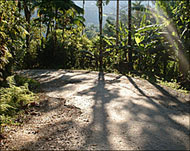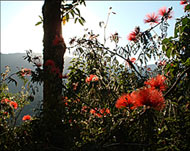Brazil losing battle for Amazon jungle
In the heart of what is known in Brazil’s Amazon as the arc of deforestation, it is clear that the fight to save the jungle is being lost.

From the air, vast tracts could be seen of cleared land with grazing cattle or cultivated fields that have been gouged out of the forest.
The land is irresistible for farmers seeking to expand and benefit from Brazil‘s agricultural boom.
The arc is the front line in the battle over the Amazon.
In 2004, the government decided to make a stand in this half-moon shaped area stretching along the southern and eastern edges of the Amazon.
A year later, environmentalists and government officials have little to show for the effort.
The government said on Wednesday that deforestation jumped to its second highest level on record in 2003-2004 to 26,130 sq km – an area nearly the size of Belgium and slightly bigger than the US state of New Hampshire.
World’s largest forest
 |
|
Deforestation has jumped to its |
Just under 20% of the world’s largest tropical forest, which is home to an estimated 30% of the world’s animal and plant species, has now been destroyed.
Even if last year was below the deforestation record of 29,050 sq km reached in 1994-1995, the deforestation levels during the past three years have never been so consistently high, all above 20,000 sq km.
The Green Party quit President Luiz Inacio Lula da Silva’s centre-left ruling coalition on Thursday in anger at the figures.
“The terrible data reflects not just a failure of implementation of the government’s plan but also the contradiction the government has in containing deforestation or promoting agriculture for exports,” Greenpeace Amazon coordinator Paulo Adaria said.
Only three employees
On the ground in Alta Floresta, a hot spot for deforestation in the southern Amazon, the government’s environmental agency Ibama has just three full-time employees to monitor an area of 56,000 sq km.
|
“We are arriving after the fish have died and the trees have been felled” |
“Since January (the end of the rainy season) the chainsaws have started roaring and we don’t have the necessary agility,” said Mauro Baldini, an Ibama environmental analyst in Alta Floresta.
“We are arriving after the fish have died and the trees have been felled,” he said.
An estimated 350 logging companies operate in the region.
A preliminary report by Greenpeace found that just three of 19 Ibama posts earmarked to get extra funding have received anything from the government’s plan to fight deforestation since it was launched in March 2004. Baldini’s post is one of the three.
Illegal loggers
Environmentalists say deforestation is driven by illegal loggers first moving in, followed by land speculators or farmers.
 |
|
Deforestation is driven by illegal |
In the Alta Floresta region their arrival is spurred by the planned paving of a road linking Cuiaba in Mato Grosso state to Santarem, hundreds of miles further north through virgin forest.
Environmentalists say the pattern is familiar – when loggers and farmers know roads are coming, they race to cut down forest to get land which they will make a profit on.
The building of a highway from capital Brasilia in the centre of Brazil to Belem on the mouth of the Amazon River several decades ago, led to mass destruction of the eastern Amazon.
The pattern can be seen perfectly in the town of Novo Progresso, just north of Alta Floresta in the state of Para, where an estimated 80% of land registrations are illegal, according to the Greenpeace report.
Logging represents 17% of the poor state of Para‘s economic output.